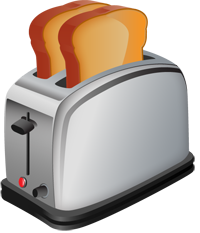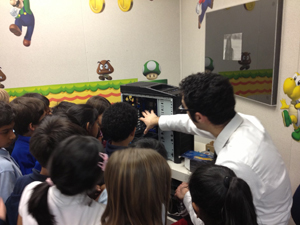Fundamentals
 The first step in any curriculum is to develop a foundation for the students. When asking young students to point to their computer, the first thing that they point to is often the monitor. It makes sense after all; everything you do on the computer magically appears there on your screen right before your eyes. Students are surprised to find that their screen does not have a “brain” at all. All of the “magic” happens in the mysterious box sitting beside their screen.
The first step in any curriculum is to develop a foundation for the students. When asking young students to point to their computer, the first thing that they point to is often the monitor. It makes sense after all; everything you do on the computer magically appears there on your screen right before your eyes. Students are surprised to find that their screen does not have a “brain” at all. All of the “magic” happens in the mysterious box sitting beside their screen.
Computers may seem complicated, but at it’s heart the general concepts are not difficult for young minds to grasp.  One of the first lessons taught involves having the students sit in a circle with the teacher in the center with a covered box. I ask the students, “if you could compare a computer to any object, what would it be most similar to?” The students get very creative with their answers, thinking of complicated machines and elaborate items. They are always surprised when they discover the item that I have in the box is a toaster. Reading this, you may wonder, “what does a toaster have to do with a computer?”. Plug in the toaster and put a piece of bread inside. Press the button and in about a minute or so, you have toast! The concept behind computers works in a very similar way. Data or information goes in, the computers processor does something to it and sends it back out in the same way your toaster alters the bread by toasting it and returning it to you for your breakfast.
One of the first lessons taught involves having the students sit in a circle with the teacher in the center with a covered box. I ask the students, “if you could compare a computer to any object, what would it be most similar to?” The students get very creative with their answers, thinking of complicated machines and elaborate items. They are always surprised when they discover the item that I have in the box is a toaster. Reading this, you may wonder, “what does a toaster have to do with a computer?”. Plug in the toaster and put a piece of bread inside. Press the button and in about a minute or so, you have toast! The concept behind computers works in a very similar way. Data or information goes in, the computers processor does something to it and sends it back out in the same way your toaster alters the bread by toasting it and returning it to you for your breakfast.
From here, students discover how software and data work as the computer knows it, binary code. Students are amazed at how a combination of “ons” and “offs” are read by the computer as 0s and 1s which when used in sequences of 8 become bytes, concepts that connect with the Computer Science and Programming branch.

Students learn about the purpose of the operating system and how to use productivity software and the World Wide Web. Internet safety, proper ergonomics, and file management is also covered in this portion of the curriculum.
Breaking down how the computer works is essential to the learning process. Rather than seeing the computer as a strange box of magic, students instead understand how it works and learn to use it as an extension of their own thoughts and ideas.
The Fundamentals branch also give students the opportunity to learn about how to utilize productivity software to collaborate, communicate, and excel forward. Spreadsheet software like Google Sheets and Microsoft Excel allows students to apply math and calculations, analyze data, and eventually leads to an understanding of databases. Applications like Microsoft Word and Google Docs allow students to communicate and collaborate. Presentation tools such as Microsoft Power Point, Google Slides, Microsoft Sway, and Prezi are also excellent conduits for communication which students can use to present their ideas while applying what they learn from the Graphic Design branch.
Another critical topic in the 21st century is that of digital citizenship. While the internet, Web 2.0 technologies, and digital spaces present new opportunities for learning and growth, they also pose new challenges and pitfalls. Learning to maximize these tools for success and community are essential skills in today’s world. This involves students understanding how to conduct proper research and analyze information online, be aware of what kind of personal information they divulge online, an understanding of cyberbullying and its implications, and other topics related to navigating the digital frontier safely.
